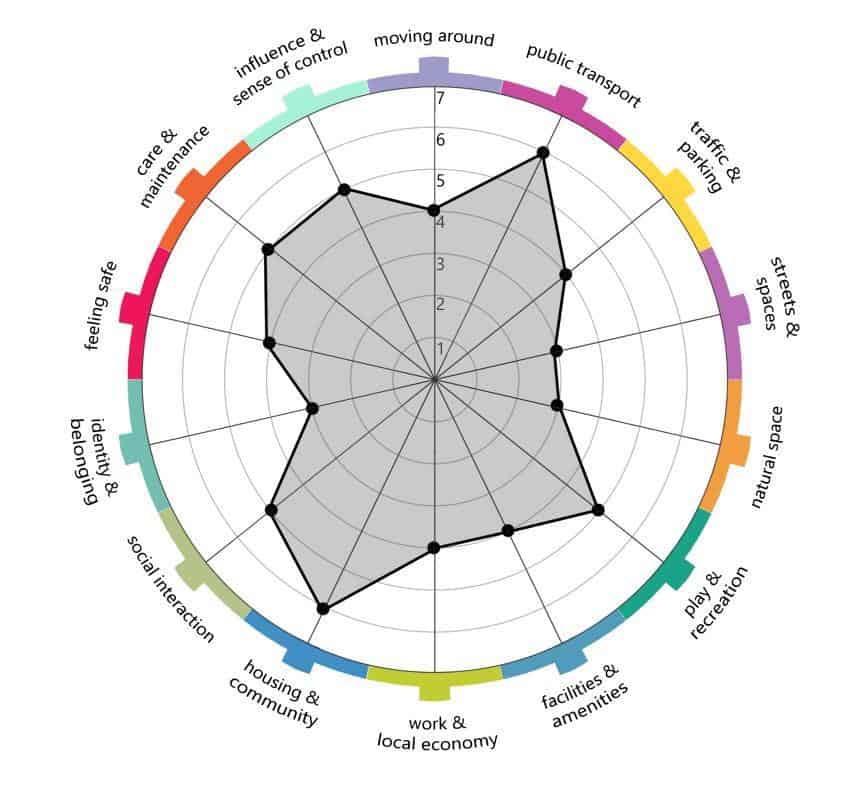The Place Standard is a tool to facilitate effective conversation between organisations, businesses and communities to identify both the assets of a place, and areas deemed priority for improvement. It provides a simple framework to structure conversations about place, allowing you to think about physical elements (such as its buildings, spaces, and transport links) as well as social aspects (for example whether people feel they have a say in decision making).
Launched on 10th December 2015 in Edinburgh, Scotland, its successful application has now extended across Europe. Today it is used by all 32 municipalities in Scotland, is supported by a national governance framework and a network of place standard leads in each municipality. These are people appointed by each municipality and national park in Scotland to be the first point of contact for the national team and to provide support and advice to colleagues and other local services. The tool continues to be used in new, international settings.
John Howie explains the origins of the tool, and why it is so internationally appealing.
The relationship that exists between the fundamental causes of our physical, social and economic environments and the immediate or eventual impacts these environments or “places” have on population health and inequalities are well documented.
However, discussing these relationships can often become overly complicated, and as a result a conversation accessible to only those with deep knowledge and understanding of public health theory and systems. This is not helpful, given the responsibility of creating healthy places is shared across multiple stakeholders, most of whom have no “formal” public health connections.
Can we simplify the public health conversation?

In 2012, Scotland’s policy statement on architecture and place ‘Creating Places’ made a commitment to design a place standard tool. This created two key challenges. The first to design a resource that ensured the foundations of public health and place making theory were fully embedded. The second to design a resource that successfully empowered communities to positively influence and help shape the decisions that impact on their living environments. In other words: an evidence-based tool that could be used by everyone.
In other words: an evidence-based tool that could be used by everyone.
The task brought together a team of public health scientists, architects and town planners who together embarked upon a process of design, testing, redesign and more testing. After 30 months the final outcome was an accessible place making tool with supporting guidance. The tool itself consisted of 14 easy to understand questions. Participants answer by giving a rating on a scale of 1-7. The results shown on a compass diagram which shows, as a glance, the areas where a place is performing well and where there is room for improvement. Prompts are given for agreeing both the priorities for change and the actions required to deliver these improvements.
Can the tool be used by everyone?
In short, yes. In Scotland early momentum was generated by the Community Empowerment (Scotland) Act 2015. This act placed a legislative requirement on community planning partnerships to engage with the public in the design of local improvement plans. The tool was seen by many municipalities as a meaningful way of delivering on this requirement. Coupled with the early development of a national implementation plan, this meant the use of the tool quickly spread across the nation. In the first 18 months after the launch, the use of the tool ranged from informing city development plans and local neighbourhood priorities to supporting school and university curriculums. These early successes did not go unnoticed. In 2017, the place standard tool won the award for Excellence in Planning for Well-being in the Royal Town Planning Institute’s awards for planning excellence.

Taking the tool to new countries and settings.
In July 2016, a Country Exchange Visit to Ljubljana jointly hosted by EuroHealthNet and the Slovenian National Institute of Public Health was linked to the WHO Summer School on “advocacy and translation of evidence for different audiences on intersectoral action for health equity and well-being”. The place standard was presented as an emerging practice.
The response was positive and as interest across the region grew the WHO European Network of Healthy Cities and NHS Health Scotland agreed to host the tool’s first WHO international masterclass in September 2017. Vital to the success of this 2-day event was the sharing of early international practice. This included the first translation and application of the tool by EuroHealthNet partners in the Netherlands. The positive lessons learned in applying the tool in the town of Sas Van Gent very much mirrored those emerging in Scotland in both processes and outcome. One such important lesson was the need for local flexibility in both the design and the subjects covered in the prompt questions under each dimension. This observation would become a repeating theme.

A second broader lesson was an acknowledgement that the tool’s dimensions clearly aligned with the United Nations Sustainable Development Goals. This was considered a very powerful dynamic as this could offer organisations and communities a product that supports the delivery of global targets through simple conversation and local solutions.
With international transferability tested successfully and a commitment by other masterclass partners to test the tool a new wave of projects began in the UK, Lithuania, Turkey and Denmark. Separately the INHERIT programme selected the tool as a ‘Triple Win Case Study’ (improving the environment, health, and health equity) and in 2018 approved funding for the application and evaluation of the tool in Riga, Latvia and Skopje, North Macedonia. Similar to previous experiences, the simplicity of the tool both in translation and application proved critical in the successful collaboration of communities, organisations and local politicians in identifying jointly what works and what needs improving upon within their local areas. In follow up in Skopje in November 2018, a visit by NHS Health Scotland witnessed first-hand the political commitment to progressing the results. In Latvia the use of the tool has now been extended to the City of Ogre and by late summer 2019 further translations and application of the tool was underway in Norway, Greece and Germany.

In view of the tool’s widening appeal and Scotland’s overall ‘place agenda’ the WHO European Healthy Cities Network invited NHS Health Scotland to support the implementation of the Copenhagen Consensus of Mayors Healthier and happier cities for all by establishing a new Place, Health, Inequalities and Well-being working group. This forum is now fully operational.

What next
Following the Making Place conference in Glasgow June 2019 that celebrated the tool’s first phase of delivery, a new 3-year strategy will be published in December 2019. Year one will launch the Place Standard Tool V2, a toolkit for designers and a children’s and a young person’s version. The Scottish programme will also focus its national work on supporting 5 key policy areas:
- Housing
- The Climate Change Emergency
- Town Centres & Local Services
- Movement & Transport
- Engaging Diverse Groups

At an international level, the plan is to combine these new tools and offer as a single resource a new WHO accredited placemaking toolkit. This is also anticipated in 2020.
Footnote
The place standard tool is a free online resource and a useful product for all professionals and communities interested in improving the quality of places through effective collaboration.
For further information please contact John Howie at [email protected]

John Howie
John Howie is currently responsible for leading the organisation’s place and place standard portfolios. He is public health adviser to the Scotland’s Towns Partnership Board and chair of the WHO European Network of Healthy Cities working group for Place, Health, Inequalities and Well-being.
